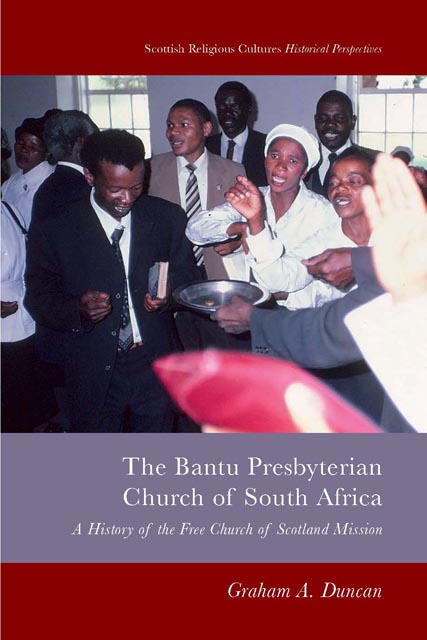Book contents
- Frontmatter
- Contents
- Acknowledgements
- Timeline
- A Presbyterian Anthem
- Introduction
- 1 Background to this Study
- 2 The Origins and Early Development of Scottish Presbyterian Mission in South Africa, 1824–65
- 3 Rev. Tiyo Soga (1829–71): A Paragon of Early Indigenous Leadership
- 4 The Role of Mission Councils in the Scottish Mission in South Africa, 1864–1923
- 5 The Rev. Edward Tsewu’s Dispute with the Free Church of Scotland Mission
- 6 The Mzimba Secession, 1898: A South African ‘Disruption’
- 7 Presbyterianism in South Africa, 1897–1923: To Unite orNot to Unite?
- 8 Preparations for the Formation of the Bantu Presbyterian Church of South Africa, 1897–1919
- 9 The Formation of the Bantu Presbyterian Church of South Africa, 1920–3
- 10 Mission to Church – Church to Mission: The First Ten Years, 1923–33
- 11 Reaching Out: The Bantu Presbyterian Church in South Africa and the Presbyterian Church of South Africa and Ecumenism, 1923–39
- 12 The Bantu Presbyterian Church in South Africa and Ecumenism, 1940–99
- 13 The End of Mission Councils: The Church of Scotland South Africa Joint Council, 1971–81
- 14 A Young Church in Mission or Maintenance Mode?: The Bantu Presbyterian Church of South Africa, 1923–99
- 15 The Bantu/Reformed Presbyterian Church and Socio-political Issues
- 16 Bantu/Reformed Presbyterian ChurchWomen in Leadership in Ministry
- Conclusion: Indigenous Presbyterians and Missionaries –Transferring Contending Roles and Responsibilities
- Bibliography
- Index
10 - Mission to Church – Church to Mission: The First Ten Years, 1923–33
Published online by Cambridge University Press: 26 November 2022
- Frontmatter
- Contents
- Acknowledgements
- Timeline
- A Presbyterian Anthem
- Introduction
- 1 Background to this Study
- 2 The Origins and Early Development of Scottish Presbyterian Mission in South Africa, 1824–65
- 3 Rev. Tiyo Soga (1829–71): A Paragon of Early Indigenous Leadership
- 4 The Role of Mission Councils in the Scottish Mission in South Africa, 1864–1923
- 5 The Rev. Edward Tsewu’s Dispute with the Free Church of Scotland Mission
- 6 The Mzimba Secession, 1898: A South African ‘Disruption’
- 7 Presbyterianism in South Africa, 1897–1923: To Unite orNot to Unite?
- 8 Preparations for the Formation of the Bantu Presbyterian Church of South Africa, 1897–1919
- 9 The Formation of the Bantu Presbyterian Church of South Africa, 1920–3
- 10 Mission to Church – Church to Mission: The First Ten Years, 1923–33
- 11 Reaching Out: The Bantu Presbyterian Church in South Africa and the Presbyterian Church of South Africa and Ecumenism, 1923–39
- 12 The Bantu Presbyterian Church in South Africa and Ecumenism, 1940–99
- 13 The End of Mission Councils: The Church of Scotland South Africa Joint Council, 1971–81
- 14 A Young Church in Mission or Maintenance Mode?: The Bantu Presbyterian Church of South Africa, 1923–99
- 15 The Bantu/Reformed Presbyterian Church and Socio-political Issues
- 16 Bantu/Reformed Presbyterian ChurchWomen in Leadership in Ministry
- Conclusion: Indigenous Presbyterians and Missionaries –Transferring Contending Roles and Responsibilities
- Bibliography
- Index
Summary
Introduction
At the inauguration of the Bantu Presbyterian Church, the Moderator of the first General Assembly, Rt Rev. William Stuart, commented:
Little wonder if the taking of this step had occasioned doubts, fears and anxieties in the minds of some of our people … It has been well for ourselves and for these communities that the taking of this step has been a matter of long continued earnest deliberation, much consultation and many earnest prayers. (Moderatorial Address BPCSA GA 1923: 35)
Discussions, arguments, secessions and plans preceded this step. It had been a long, arduous and complex journey but one which eventually bore fruit. It was now up to the church to prove its worth by making its mark both in the ecclesiastical and wider context of South Africa.
Yet, this happened despite Elphick's (2012: 81) view that:
By the 1920s, after Protestants had been conducting intensive missions in parts of South Africa for more than a century, the fulfilment of the implication of their gospel – that the equality of believers before God entailed equality of black and white in church and society – had been, it seemed, indefinitely postponed.
Whatever their personal reservations about Africans’ abilities, no missionaries publicly advocated perpetual European domination of the African church, although they demonstrated little confidence in the short- and middle-term prospects of the success of such ventures as the formation of autonomous back churches. In theory, the principles of Christian universalism and the indigenous church dovetailed neatly, since the proclamation of a single gospel throughout the world would give rise to churches equal in stature though implanted in different cultures. In South Africa, however, where white Christians had founded well-endowed and cohesive churches, the two principles were in tension. Universalism in South Africa meant close fellowship and effective equality between white and black Christians, while the doctrine of indigenous churches implied that Africans, with their distinctive cultures, would go their own way, as whites would go theirs (Elphick: 94–5).
Therefore, the Bantu Presbyterian Church of South Africa (BPCSA) was birthed in the midst of racial tension, but also in the context of dependency and the argument for independence, two themes at the core of the Missionary Movement.
- Type
- Chapter
- Information
- Bantu Presbyterian Church of South AfricaA History of the Free Church of Scotland Mission, pp. 123 - 136Publisher: Edinburgh University PressPrint publication year: 2022



